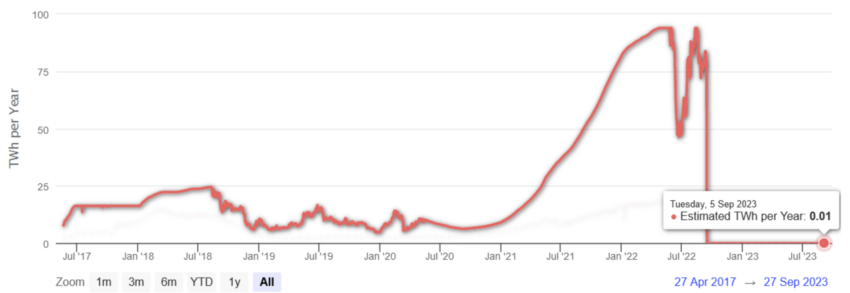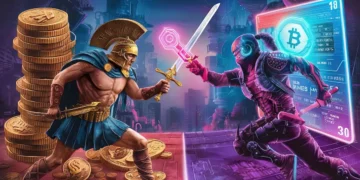Blockchains rely on consensus mechanisms to verify transactions, but why does it matter if a network is proof-of-work (PoW) or proof-of-stake (PoS)? In this guide, we’ll break down PoW vs. PoS in simple terms, explaining how each method secures the blockchain while addressing the pros and cons and features of each. Here’s what to know in 2024.
In this guide:
- What is proof-of-work (PoW)?
- What is proof-of-stake (PoS)?
- Proof-of-work vs. proof-of-stake: Comparison
- Challenges associated with PoW
- Challenges associated with PoS
- Which consensus is better: PoS or PoW?
- Frequently asked questions
What is proof-of-work (PoW)?
Proof-of-work (PoW) is a consensus mechanism where miners use computational power to solve complex mathematical puzzles and validate transactions on a blockchain. This process ensures the network is secure and decentralized through the competition of miners.
Key characteristics of PoW
- Mining-based validation: Miners compete to solve cryptographic puzzles, with the winner getting to validate a block and receive rewards.
- Energy-intensive: Just like a giant puzzle competition requires energy, PoW uses a lot of computational power, making it energy-intensive.
- Security through difficulty: The complexity of the puzzles makes it very difficult for anyone to tamper with the network. Any changes would require re-solving all previous puzzles, which is practically impossible.
How PoW ensures security and decentralization
PoW provides security by making it extremely costly to try to attack or manipulate the network. The resources needed to cheat are so high that it’s not worth the effort. At the same time, PoW allows anyone with the right hardware to participate in mining, ensuring no single entity controls the network.
Examples of blockchains using PoW
- Bitcoin: The first cryptocurrency to implement PoW, Bitcoin’s decentralized network relies on miners to secure the blockchain.
- Litecoin: A fork of Bitcoin, Litecoin uses PoW but offers faster transaction times, making it more suitable for smaller, everyday transactions.
What is proof-of-stake (PoS)?
Proof-of-stake (PoS) is a consensus mechanism where validators are chosen to create new blocks based on the amount of cryptocurrency they hold and are willing to “stake” as collateral. This method reduces the need for energy-intensive computations and increases network efficiency.
Key characteristics of PoS
- Staking replaces mining: Instead of miners, PoS uses validators who lock up (or stake) their coins for a chance to validate blocks.
- Energy efficiency: Since PoS doesn’t rely on heavy computation, it consumes significantly less energy than PoW.
- Validator selection based on stake: Validators are chosen based on how many coins they have staked, which incentivizes holding and securing the network.
Staking and validator selection process
In PoS, validators lock up a portion of their cryptocurrency as collateral. When selected, they validate new transactions and add them to the blockchain. If they act dishonestly, their staked coins can be slashed (lost), ensuring participants follow the rules. This system favors those who have a large stake but also allows smaller holders to participate.
Examples of blockchains using PoS
- Cardano: A leading PoS blockchain known for its research-driven approach, Cardano emphasizes security and sustainability through staking.
- Ethereum: After its transition from PoW in 2022, Ethereum now uses PoS, greatly increasing its energy efficiency and scalability.
Proof-of-work vs. proof-of-stake: Comparison
While the differences can always be detailed, here is a quick table for your reference, which might help you make better sense of how each works:
Challenges associated with PoW
While proof-of-work (PoW) is widely recognized for its security and decentralization, it comes with significant challenges. Its energy consumption, centralization risks, and slow transaction speeds pose limitations for scalability.
High energy consumption
One of PoW’s most talked-about drawbacks is its environmental impact. The energy required to solve cryptographic puzzles is massive, leading to concerns about sustainability. This has prompted debates about greener alternatives in blockchain technology.
Bitcoin’s enormous transactional, trust, and security advantages are offset by the actively resource-intensive design of its transaction verification process, which now compromises our ability to survive in a climate-dependent world.
Truby, J. (2018). Decarbonizing Bitcoin: Science Direct
The chart below demonstrates the change in Ethereum’s energy consumption after moving from a PoW consensus mechanism to PoS.

Ethereum energy consumption: Limenet.tech
Centralization risks due to mining pools
As mining becomes more competitive and hardware-intensive, smaller miners struggle to compete. This has led to the rise of mining pools — groups of miners who combine their resources to solve puzzles together. While this makes mining more efficient, it also risks centralizing power in the hands of a few large pools, which could undermine the decentralization principle of PoW.
Slower transaction times
PoW networks like Bitcoin process transactions at a slower pace compared to newer consensus mechanisms. As miners need time to solve each puzzle, block generation can take longer, causing delays in transaction validation, especially during periods of high network traffic.
Challenges associated with PoS
Proof-of-stake (PoS) is praised for being energy-efficient and scalable, but it faces its own set of challenges. These include:
- Risks of centralization
- Potential security vulnerabilities
- The complexity of staking
Risks of centralization due to wealth concentration
In PoS systems, validators with larger amounts of staked cryptocurrency have a higher chance of being selected to validate blocks. This can lead to a situation where a small group of wealthy participants controls a significant portion of the network, raising concerns about centralization.
Security concerns (long-range attacks, slashing risks)
While PoS is generally considered secure, it has its own vulnerabilities. One such risk is a long-range attack, where an attacker rewrites history from far back in the blockchain.
To mitigate this, PoS systems implement penalties (slashing) for validators who act dishonestly. However, there’s a risk that honest validators might be penalized by accident, leading to the potential loss of staked coins.
Complexity of the staking process
Staking can be a complicated process, especially for beginners. Validators need to understand how much to stake, manage the risks of slashing, and stay online to maintain their role in the network. This complexity may discourage smaller holders from participating, potentially leaving the system in the hands of more experienced or wealthier users.
As of 2024, several hybrid models are being explored, combining aspects of both PoW and PoS. For example, projects like Kadena use PoW for security and PoS for governance to strike a balance between security and energy efficiency.
Which consensus is better: PoS or PoW?
There isn’t a clear winner in this proof-of-work vs. proof-of-stake discussion; each has its strengths and weaknesses depending on the use case. However, as blockchain technology matures, PoS is gaining more attention for its energy efficiency, sustainability, and scalability, while PoW remains trusted for its high level of security.
While many new chains choose to embolden greener credentials with PoS, the status of the original and most popular blockchain, Bitcoin, as PoW ensures that the more energy-intensive consensus mechanism will remain relevant in the long term.





















































































Blue Techker I am truly thankful to the owner of this web site who has shared this fantastic piece of writing at at this place.
Outstanding post, you have pointed out some wonderful details , I too conceive this s a very excellent website.
It’s actually a great and useful piece of info. I’m glad that you shared this helpful information with us. Please keep us informed like this. Thanks for sharing.
As soon as I observed this internet site I went on reddit to share some of the love with them.
Purdentix review
I’m really impressed by the speed and responsiveness.
The layout is visually appealing and very functional.
It provides an excellent user experience from start to finish.
I’m really impressed by the speed and responsiveness.
The layout is visually appealing and very functional.
I love how user-friendly and intuitive everything feels.
This website is amazing, with a clean design and easy navigation.
AI is evolving so fast! I can’t wait to see how it transforms our daily lives in the next decade. The possibilities are endless, from automation to medical advancements.
Christopher Nolan’s storytelling is always mind-blowing. Every movie feels like a masterpiece, and the way he plays with time and perception is just genius.
Watching a sunset over the ocean is one of the most peaceful experiences in life. Nature has a way of reminding us how small but connected we all are.
The potential within all things is a mystery that fascinates me endlessly. A tiny seed already contains within it the entire blueprint of a towering tree, waiting for the right moment to emerge. Does the seed know what it will become? Do we? Or are we all simply waiting for the right conditions to awaken into what we have always been destined to be?
This blog has opened my eyes to new ideas and perspectives that I may not have considered before Thank you for broadening my horizons
Virtue, they say, lies in the middle, but who among us can truly say where the middle is? Is it a fixed point, or does it shift with time, perception, and context? Perhaps the middle is not a place but a way of moving, a constant balancing act between excess and deficiency. Maybe to be virtuous is not to reach the middle but to dance around it with grace.
Man is said to seek happiness above all else, but what if true happiness comes only when we stop searching for it? It is like trying to catch the wind with our hands—the harder we try, the more it slips through our fingers. Perhaps happiness is not a destination but a state of allowing, of surrendering to the present and realizing that we already have everything we need.
Time is often called the soul of motion, the great measure of change, but what if it is merely an illusion? What if we are not moving forward but simply circling the same points, like the smoke from a burning fire, curling back onto itself, repeating patterns we fail to recognize? Maybe the past and future are just two sides of the same moment, and all we ever have is now.
Friendship, some say, is a single soul residing in two bodies, but why limit it to two? What if friendship is more like a great, endless web, where each connection strengthens the whole? Maybe we are not separate beings at all, but parts of one vast consciousness, reaching out through the illusion of individuality to recognize itself in another.
Even the gods, if they exist, must laugh from time to time. Perhaps what we call tragedy is merely comedy from a higher perspective, a joke we are too caught up in to understand. Maybe the wisest among us are not the ones who take life the most seriously, but those who can laugh at its absurdity and find joy even in the darkest moments.
The potential within all things is a mystery that fascinates me endlessly. A tiny seed already contains within it the entire blueprint of a towering tree, waiting for the right moment to emerge. Does the seed know what it will become? Do we? Or are we all simply waiting for the right conditions to awaken into what we have always been destined to be?
The cosmos is said to be an ordered place, ruled by laws and principles, yet within that order exists chaos, unpredictability, and the unexpected. Perhaps true balance is not about eliminating chaos but embracing it, learning to see the beauty in disorder, the harmony within the unpredictable. Maybe to truly understand the universe, we must stop trying to control it and simply become one with its rhythm.
Friendship, some say, is a single soul residing in two bodies, but why limit it to two? What if friendship is more like a great, endless web, where each connection strengthens the whole? Maybe we are not separate beings at all, but parts of one vast consciousness, reaching out through the illusion of individuality to recognize itself in another.
Amazing! This blog looks just like my old one! It’s on a entirely different topic but it has pretty much the same layout and design. Superb choice of colors!
You are a very intelligent person!
clomiphene rx how can i get cheap clomid tablets buying generic clomid without prescription cost generic clomiphene online can i buy generic clomid how can i get cheap clomiphene without prescription buying cheap clomid pill
Greetings! Very useful recommendation within this article! It’s the little changes which will espy the largest changes. Thanks a lot towards sharing!
More posts like this would force the blogosphere more useful.
azithromycin online buy – ciplox 500mg without prescription metronidazole where to buy
semaglutide 14mg for sale – semaglutide medication buy cyproheptadine 4 mg online cheap
order domperidone 10mg generic – motilium 10mg brand flexeril online order
The next time I learn a blog, I hope that it doesnt disappoint me as a lot as this one. I mean, I know it was my option to learn, but I truly thought youd have something attention-grabbing to say. All I hear is a bunch of whining about something that you can repair should you werent too busy searching for attention.
order inderal 20mg online – clopidogrel online generic methotrexate 5mg
I like the valuable information you supply in your articles. I’ll bookmark your weblog and test once more here regularly. I am quite certain I’ll be told many new stuff right here! Good luck for the following!
buy azithromycin 500mg pills – zithromax 250mg canada purchase nebivolol online
buy augmentin 1000mg without prescription – https://atbioinfo.com/ buy ampicillin cheap
purchase nexium without prescription – https://anexamate.com/ nexium brand
buy warfarin 5mg – anticoagulant cheap losartan
I love your writing style really loving this website .
purchase mobic pills – relieve pain buy mobic paypal
blue pill for ed – low cost ed pills ed pills no prescription
cheap fluconazole – order fluconazole 200mg pill how to buy diflucan
lexapro order – https://escitapro.com/ cheap lexapro 10mg
cenforce pill – https://cenforcers.com/# purchase cenforce generic
order zantac 300mg sale – buy ranitidine without prescription order ranitidine 150mg online
what does cialis treat – https://strongtadafl.com/ free cialis samples
Greetings! Utter useful advice within this article! It’s the crumb changes which choice turn the largest changes. Thanks a quantity in the direction of sharing! site
100mg viagra – buy viagra generic usa viagra without a doctor prescription
The vividness in this piece is exceptional. gabapentin 600mg cost
Thanks for sharing. It’s outstrip quality. ursxdol
The thoroughness in this break down is noteworthy. https://prohnrg.com/product/diltiazem-online/
I have recently started a blog, the information you provide on this website has helped me greatly. Thanks for all of your time & work.
The thoroughness in this break down is noteworthy. https://aranitidine.com/fr/en_ligne_kamagra/
I am in point of fact thrilled to glance at this blog posts which consists of tons of profitable facts, thanks for providing such data. https://ondactone.com/simvastatin/
Greetings! Very productive suggestion within this article! It’s the little changes which will turn the largest changes. Thanks a quantity for sharing!
https://doxycyclinege.com/pro/meloxicam/
The reconditeness in this piece is exceptional. http://ledyardmachine.com/forum/User-Vfeest
Hello. Great job. I did not anticipate this. This is a splendid story. Thanks!
naturally like your web site however you have to take a look at the spelling on quite a few of your posts. Many of them are rife with spelling problems and I find it very troublesome to inform the truth on the other hand I will surely come again again.
buy forxiga generic – forxiga pills buy forxiga 10 mg for sale
xenical price – purchase xenical buy xenical 120mg without prescription
More delight pieces like this would urge the web better. http://mi.minfish.com/home.php?mod=space&uid=1420954